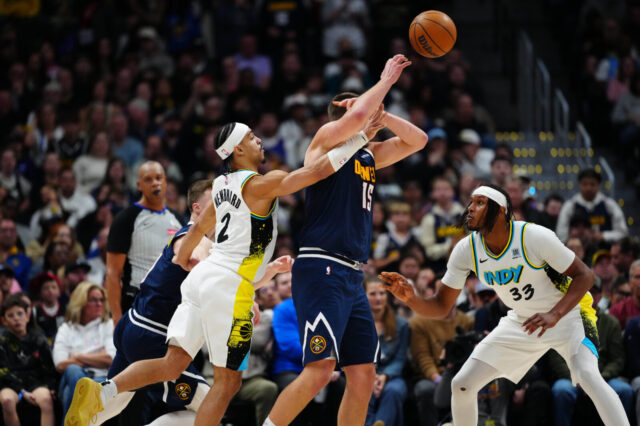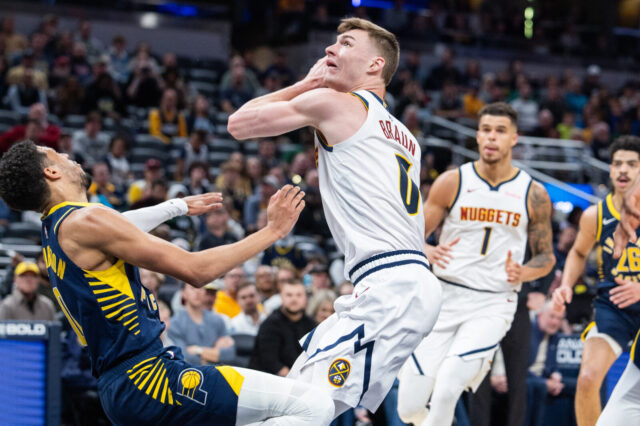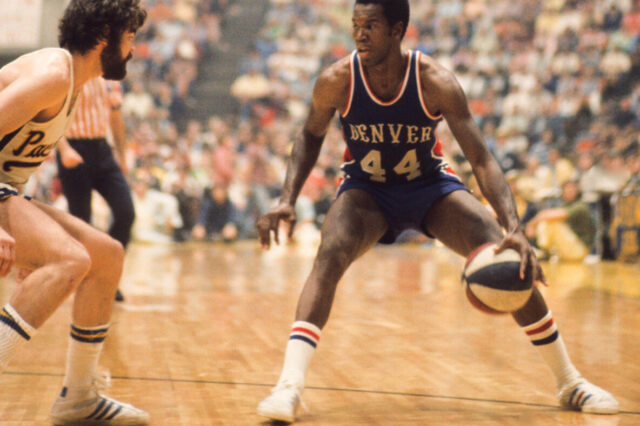If you’re not familiar with Film Fridays, each Friday, I’ll be looking at some recent Denver Nuggets’ games, lineups or something else from a film aspect to try and bring you a piece of content that you’re not getting somewhere else. Feel free to give any feedback positive or negative in the comments or find me on Twitter.
In the NBA, you play a minimum of two halves in every game. Sometimes, you add an overtime or two in there, but, no matter what, you’re playing those two halves. In the first half of games, the Nuggets have the NBA’s sixth-best net rating with a +7.3. Their 118.4 offensive rating is the league’s best by a full 1.4 points. In the second half, the story is not nearly as rosy for a team with playoff aspirations and beyond.
Denver’s net rating goes from +7.3 in the first half to a -2.9 in the second half, which is the 23rd-best mark in the league. One might assume that it’s a combination of offensive and defensive issues right? Well, you’d be wrong. The team’s defensive rating goes from a 111.0 in first halves to a 110.8 in second halves. Meanwhile, their offense absolutely craters into the Earth as it goes from a sparkling 118.4 in the first half down to a 107.9, which is the fifth-worst mark in the league. The Nuggets are the only team currently in a playoff spot in either conference that sports an offensive rating in the bottom third of the league during the second half.
So, what is it about this team that causes them to fall off so harshly in the second half of games? Obviously, some of these numbers might be slightly skewed due to blowout wins and losses resulting in bench minutes with less efficient offense, but the general premise is still clear. Denver has a second-half offense problem, and it’s going to keep causing problems. Going over their last five losses, excluding the loss to the Boston Celtics which was a blowout before the second half, the Nuggets have been outscored by 70 points over the course of those 10 quarters. In those five losses, they have won just one quarter. That’s an average of 14 points per half. Meaning, Denver would have needed a lead of 15 or more to hold onto a win. What is going on that makes that such an impossibility for this team?
Find A Rhythm
Are there guys on the team that can take and make this shot consistently? Absolutely. Do any of those guys ever pump fake themselves out of the shot? No. JaMychal Green has plenty of space on this shot. There is still plenty of time left on shot clock, but it’s clear that he doesn’t want to take this shot. So, the question becomes why take it? I can understand trying to score when you have an open shot, but, when second-guessing yourself that much, it’s better to just pass out to give someone else the look. When one player scores, the defense now has to think more about him, which leaves more space for everyone else to succeed.
Is Will Barton wide open on this shot? Yes. Are there defenders that could potentially make an attempt at contesting his look? Sure. Does Barton need to rush into this shot just to try and get a shot up? Absolutely not. The Nuggets are up by eight in the early going of the third quarter. They’re in transition just a few seconds into the shot clock. Barton, rather than fully setting himself, is still moving towards the basket when he puts the shot up, and it clangs off of the back of the rim after he puts too much power into the shot. To that point in the game, Barton had just four points, so it makes sense that he’s trying to score. Rushing a shot isn’t the way to find that flow within the game though.
More We, Less Me
Before you immediately go to the comments and assume that I’m using this clip to slander Bones Hyland, who has been playing outstanding basketball as of late, that isn’t what this is. Hyland gets the ball with 13 seconds on the shot clock. Until he puts the shot up with six seconds on the clock, no one has moved more than five feet from the spot that they started in. Are there times when iso plays are called? Yes. However, Hyland and the other ball-handlers on this team are willing passers, but they have no one to pass to if everyone is standing still and allowing the defense to all pay extra attention to the ball-handler because their assignment is moving.
While the previous play shows an example of what not to do, here’s an example of what they should be looking to go for. I know what you’re probably already thinking. Austin Rivers barely moves on this play, so how is he getting credited for movement here? This play is meant to credit Barton and Hyland more than anyone else. DeMarcus Cousins and JaMychal Green set solid screens to create room, but Barton’s move along the baseline is what leaves Rivers so wide open. When he’s darting toward the corner, Luke Kennard has to honor him in that part of the team’s zone defense. This forces him to give more room for Rivers, and Austin knocks down the open look off of the pass by Hyland. Barton gets nothing in the stat sheet other than minutes and miles run, but it’s his movement that allowed the entire team to succeed, which is what matters most.
Find Your Advantages
A pick-and-roll of Nikola Jokic and Aaron Gordon has to be one of the most frustrating plays for opposing team’s to defend. Jokic’s ability to step out and hit jump shots keeps defenders from sagging off to help on Gordon, and he’s also too good of a passer for you to send multiple guys to him, which is exactly what happens on this play. Gordon sets a hard screen on DeAndre Ayton to give Jokic a little bit of room to work. Once he’s over the screen, Gordon can cut hard to the rim, and, with his strength and speed, there’s no stopping him unless you foul him. Gordon gets fouled on this play, and he still finds a way to score. Late in the game, everything slows down. When that happens, rather than running the normal offense, find ways to exploit the things that you do well. A prime example is using your historically great-passing center in combination with your athletically gifted forward.
A fall away jumper against a smaller defender six seconds into the shot clock isn’t exactly what I would call a good shot. I understand the situation. Denver is down by eight with 30 seconds left in the game. Phoenix seemingly can’t miss, as they shot over 60 percent from the floor. However, in that situation, the goal should be to find the best shot possible to increase the likelihood of coming back. Gordon has been great this year when he’s gotten a smaller defender on him when he’s down on the block. However, most of the time, he’s worked towards the basket. This wasn’t the case, and that miss was the final dagger in the coffin as you can see the entire Nuggets’ team just lose their energy on the spot.
For those of you that are still here, remember to leave your feedback in the comments or over on my Twitter, and have a fantastic film-filled Friday.


